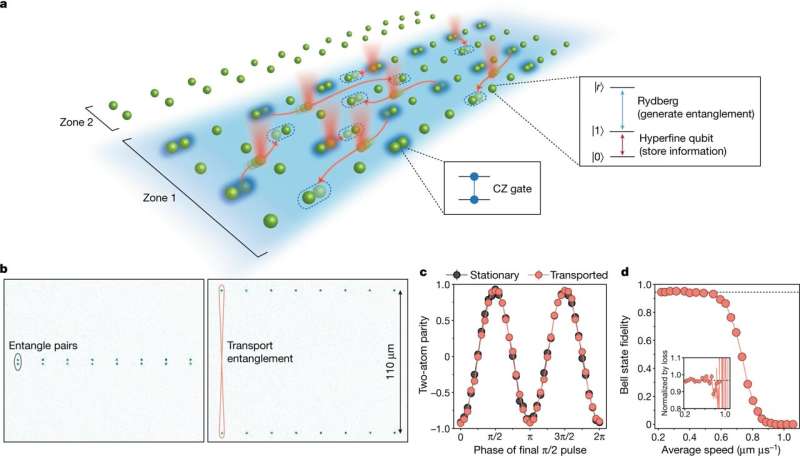April 22, 2022 report
Two teams use neutral atoms to create quantum circuits

Bob Yirka
news contributor

Two teams of researchers working independently have shown the viability of using neutral atoms to create quantum circuits—both have published outlines of their work in the journal Nature. One of the groups, with members from the University of Wisconsin, Madison, ColdQuanta and Riverlane, successfully ran an algorithm on a cold atom quantum computer for the first time. The second group, with members from Harvard, MIT, QuEra Computing Inc., the University of Innsbruck and the Austrian Academy of Sciences, showed that it was possible to build a quantum processor based on coherent transport of entangled atom arrays. Hannah Williams, with Durham University, has published a News & Views piece in the same journal issue outlining recent research into using neutral atoms to create quantum circuits and the work done by the two teams in these recent efforts.
As research into building a true and useable quantum computer has progressed, multiple designs have evolved—the two leading contenders involve the use of qubits based either on trapped ions or electrostatic fields. But both approaches have proven difficult to scale up to large systems. Because of that, some researchers have turned to studying the possibility of using neutral atoms in such a computer. The advantage of such an approach, as Williams notes, is that it would be much easier to scale to much larger systems—arrays of hundreds of neutral atoms have already been used to create logic gates. In the two new efforts, both research teams have shown that it is possible to use such an approach to create multi-qubit circuits; they just went about it in different ways.
Both teams encoded the qubits in their machines in a low energy state but differed in how they handled them. One team entangled atoms that were not adjacent to one another using optical tweezers to move them around and then used them to demonstrate that the approach could be used to realize a well-established quantum information state. The other team entangled qubit pairs using laser beams to create a complex of six qubits in a Greenberger–Horne–Zeilinger state. They then used their system to run two quantum algorithms—one that measured the molecular energy of a given atom, the other to work on the MaxCut problem.
The work by both teams suggests that using neutral atoms to create quantum circuits is a viable option for further research focused on creating a working quantum computer.
Written for you by our author —this article is the result of careful human work. We rely on readers like you to keep independent science journalism alive. If this reporting matters to you, please consider a (especially monthly). You'll get an ad-free account as a thank-you.
More information: T. M. Graham et al, Multi-qubit entanglement and algorithms on a neutral-atom quantum computer, Nature (2022).
Dolev Bluvstein et al, A quantum processor based on coherent transport of entangled atom arrays, Nature (2022).
Hannah J. Williams, Versatile neutral atoms take on quantum circuits, Nature (2022).
Journal information: Nature
© 2022 Science X Network





















